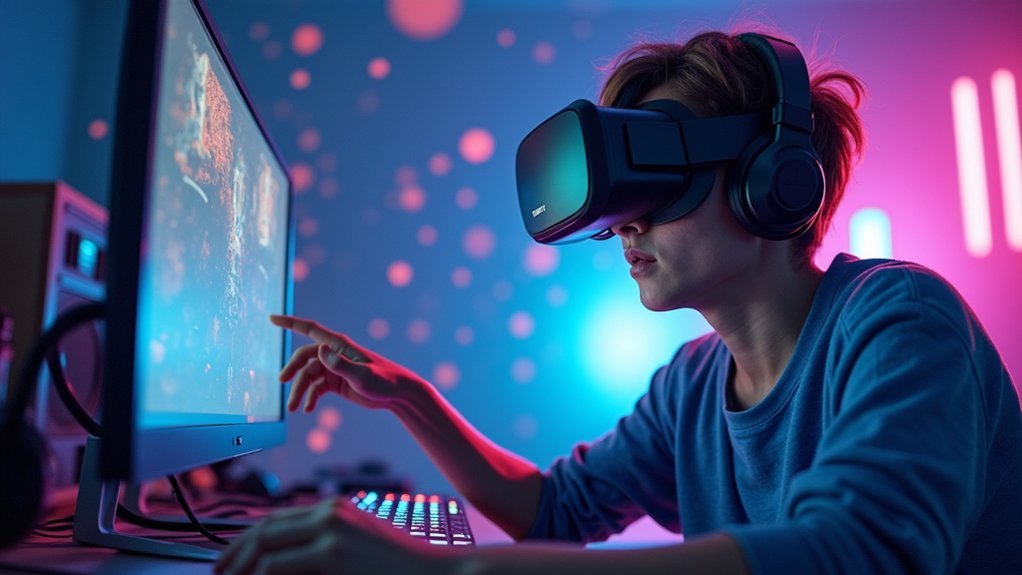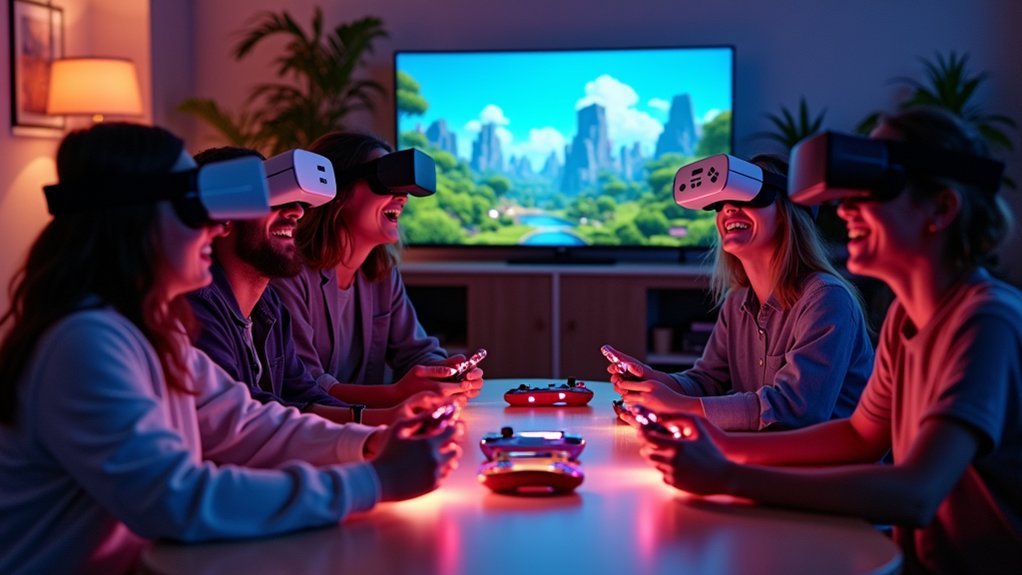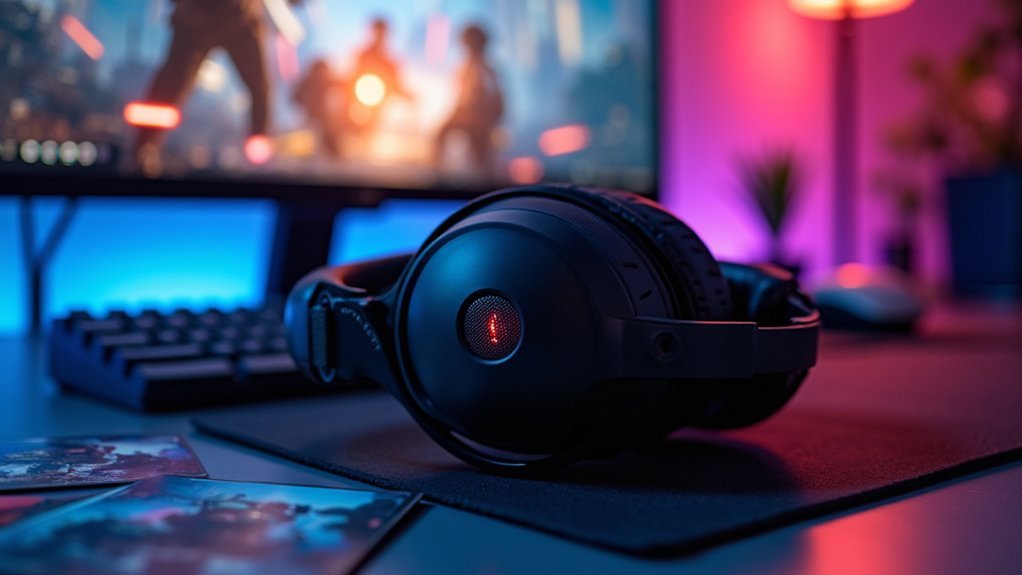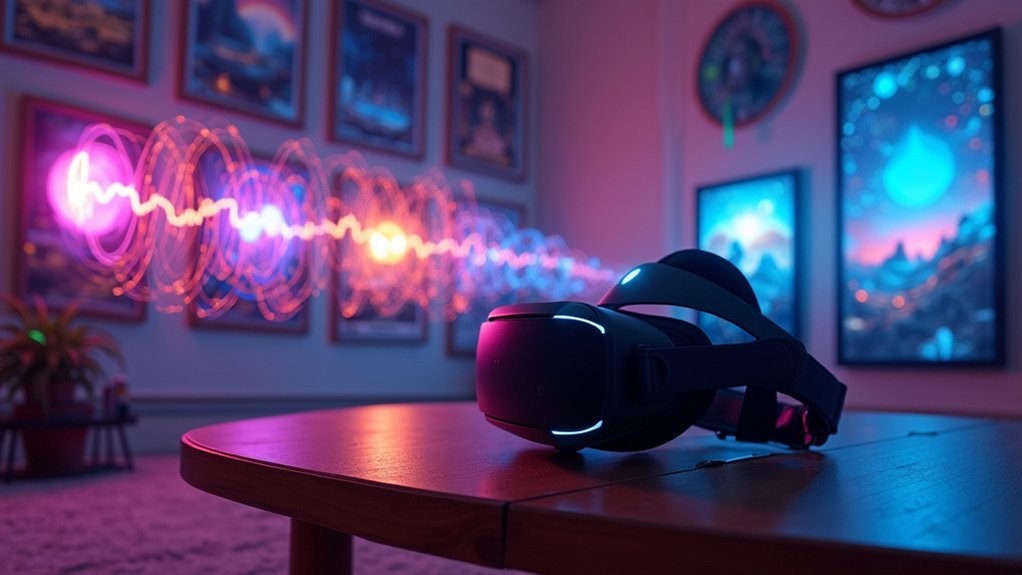You’ll find the best spatial audio experiences on Quest with games like Batman: Arkham Shadow, which uses immersive soundscapes and advanced technology integration, and Among Us VR, featuring binaural audio for precise directional sound. Ghostbusters: Rise of the Ghost Lord offers exceptional audio positioning that enhances teamwork, while Five Nights at Freddy’s: Help Wanted 2 creates dynamic sound environments that heighten tension through essential survival cues. These titles showcase how Quest’s advanced audio technologies transform your gaming experience into something extraordinary.
Top Mixed Reality Games With Advanced Spatial Audio Technology

When you’re exploring mixed reality gaming on Quest, certain titles stand out for their exceptional spatial audio implementation that transforms how you experience virtual worlds.
Batman: Arkham Shadow delivers immersive soundscapes that enhance gameplay realism through advanced technology integration.
Among Us VR showcases binaural audio capabilities, positioning sounds directionally to mirror real-world orientation in virtual reality environments.
Among Us VR’s binaural audio technology creates directionally accurate soundscapes that seamlessly translate real-world spatial awareness into immersive virtual reality gameplay.
For multiplayer games, Ghostbusters: Rise of the Ghost Lord excels at fostering teamwork through precisely positioned audio based on player locations, improving communication during cooperative sessions.
The Civilization series combines spatial audio with 360° graphics for cohesive engagement.
Five Nights at Freddy’s: Help Wanted 2 creates dynamic sound environments that heighten tension, delivering essential audio cues for survival gameplay.
Enhanced Audio Features and Technical Specifications for Immersive Gaming
Behind every exceptional Quest spatial audio experience lies sophisticated technical architecture that transforms how you perceive virtual environments.
The Quest 3’s Qualcomm Snapdragon XR2 processor powers advanced 3D spatial audio systems that create realistic soundscapes through binaural and HRTF-based technologies. You’ll experience head-tracked audio that dynamically adjusts as you move, ensuring accurate sound positioning in immersive environments.
Ambisonic audio techniques enable multidirectional sound perception, making titles like Batman’s Arkham Shadow and Among Us VR incredibly engaging.
The headset’s high-definition 1832×1920 pixel resolution per eye complements these audio features perfectly. You’ll benefit from spatially accurate audio cues that enhance multiplayer communication and strategy formation.
This technical foundation creates engaging gameplay where every footstep, whisper, and environmental sound contributes to your overall immersion.
Multiplayer and Social Gaming Experiences With 3D Sound Design

While technical specifications create the foundation for immersive audio, multiplayer Quest games elevate spatial sound design into collaborative experiences that transform how you connect with other players.
These titles showcase how 3D sound design enhances social gaming:
Modern VR titles demonstrate how sophisticated spatial audio transforms multiplayer gaming from simple voice chat into rich, collaborative soundscapes.
- Ghostbusters: Rise of the Ghost Lord – Rich spatial audio enables effective communication and team strategy coordination.
- Asgards Wrath 2 – Creates immersive environments where players collaborate seamlessly through directional audio cues.
- Among Us VR – Leverages 3D sound design to build tension while maintaining clear player communication.
- Five Nights at Freddy’s: Help Wanted 2 – Uses spatial audio to create shared fear experiences that bond players.
- Advanced audio technologies – Binaural and HRTF-based systems allow precise sound localization across distances.
You’ll discover these multiplayer experiences foster genuine community connections, making distant collaboration feel naturally present.
Understanding XR Audio Technologies: Binaural, HRTF, and Ambisonic Systems
Understanding how XR audio technologies work transforms your appreciation for the sophisticated systems powering Quest’s most immersive experiences. Binaural audio creates spatialized sound through headphones, mimicking natural hearing patterns. HRTF technology filters audio based on your head position, enabling 180-degree sound perception that enhances player engagement in XR games.
| Technology | Key Feature | Best Application |
|---|---|---|
| Binaural Audio | Natural stereo perception | General VR gaming |
| HRTF Technology | Position-based filtering | Interactive experiences |
| Ambisonic Audio | Three-dimensional sound field | 360-degree content |
Ambisonic audio utilizes multiple microphones to capture complete soundscapes, making it ideal for immersive environments. These technologies work together in Quest’s audio design, creating dynamic soundscapes that respond to your movements and interactions, fundamentally transforming how you experience virtual worlds.
Optimizing Spatial Audio Settings for Meta Quest Development

When refining spatial audio settings for Meta Quest development, you’ll need to configure FMOD properly using Oculus plug-ins to achieve the binaural output that Quest’s audio systems require.
Here are essential refinement steps:
- Set FMOD project preferences to “Mobile” and select 5.1 audio configuration for Meta Quest compatibility.
- Configure global mixer output channel settings to match device capabilities, allowing FMOD to automatically adjust when needed.
- Apply unique distance curves to each audio event and automate reverb sends based on listener distance for immersive reverb effects.
- Separate pre-processed binaural audio from real-time processing to prevent conflicts with Oculus Spatializer.
- Utilize dedicated tracks for enhanced directional sound experiences while maintaining spatial audio accuracy.
These configurations guarantee peak performance and deliver compelling spatial audio that maximizes Quest’s built-in audio capabilities.
Frequently Asked Questions
Which Games Support Spatial Audio?
You’ll find spatial audio support in Among Us VR, Five Nights at Freddy’s: Help Wanted 2, Assassin’s Creed Nexus VR, Ghostbusters: Rise of the Ghost Lord, Civilization series, and Batman: Arkham Shadow for immersive experiences.
Is Spatial Audio Good for Gaming?
You’ll find spatial audio excellent for gaming because it creates immersive three-dimensional soundscapes that enhance your situational awareness, improve decision-making through directional cues, and make multiplayer coordination more effective.
Does Quest 2 Support Spatial Audio?
Yes, your Quest 2 supports spatial audio with binaural processing and the Oculus Spatializer. You’ll experience immersive 3D sound that adjusts with head movements, whether you’re using built-in speakers or headphones.
Is Spatial Audio Better Than Dolby?
Spatial audio’s better than Dolby for VR because it dynamically tracks your head movements and adjusts sound positioning in real-time, creating more immersive experiences than Dolby’s fixed speaker configurations.
In Summary
You’ll discover that spatial audio transforms your Quest gaming experience into something truly immersive. Whether you’re exploring atmospheric adventures, battling in multiplayer arenas, or socializing in virtual spaces, 3D sound design creates unprecedented realism. You can optimize your settings by understanding binaural processing and HRTF technologies. Don’t overlook the technical specifications when choosing games—they’ll make the difference between good audio and extraordinary spatial experiences that’ll keep you coming back.





Leave a Reply